A broad, flat blade of medium length (average 31") with a fuller running the entire length and fading out an inch or so from the point, which is sometimes acute but more often rounded. This fuller is generally very wide and shallow, but in some cases may be narrower (about 1/3 of the blade's width) and more clearly defined; a short grip, of the same average length (3%") as the Viking
Swords. The tang is usually very flat and broad, tapering sharply towards the pommel. The cross is narrower and longer than the more usual Viking kind—though the Vikings used it, calling it "Gaddhjalt" (spike-hilt) because of its spike-like shape. Generally of square section, about 7" to 8" long, tapering towards the tips. In rare cases curved. The pommel is commonly of one of the Brazil-nut forms, but may be of disc form.
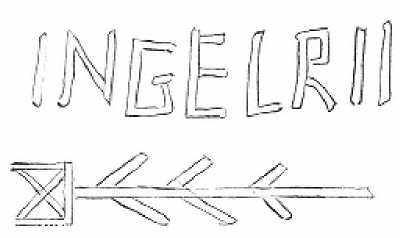
Fig. 7.
Inlays on a sword-blade, c. 950. Type VIII. (plate 1C)
General Remarks
This type may too easily be confused with Type VIII. Many swords of the two types—compare plates 1C and 2C—look identical in shape. In such cases, the only possible way out is to make use of any internal evidence the specimen itself may afford, such as inlaid marks and inscriptions in the blade. Many of these swords—of both types—are from the INGELRII workshops, while others bear similar smith-names inlaid in big iron letters. If on the reverse of such blades we find what may be called a Christian inscription (for instance INNOMINEDOMINI or a garbled version of it)12 or a pattern of non-pagan character inlaid in a different metal, such as latten or tin (or silver), then the sword would be of Type X. Good examples of both can be seen on plates 1 and 2. 1C is a sword in my own collection, with the name Ingelrii on one side and a pattern (fig. 7) similarly inlaid on the other, which is characteristic of the Viking-age patterns so familiar upon the ULFBERHT swords.
2C is a sword in the Museum of Ethnology and Archaeology at Cambridge. On one side it has the name CONSTAININUS and on the other the words INNoMiNEDNI—both in big iron letters. 1C, therefore, is of Type VIII, while 2C is of Type X. The hilts of the two appear to be identical, but the pommel of 1C is rather plump, whereas that of 2C is quite flat. Only in elevation do they look identical.
Many of the Type X swords
12For instance, an Ingelrii sword in the Zweizerisches Landesmnsenm in Zurich (plate 2A and fig. 127) has the smith-name on one side of the blade, and the words "Homodei" in smaller iron letters on the other. Inv. No. 16203, Bruhn Hoffmeyer, plate IXa and p. 9, No. 26; and Wegeli, R., Inschriften auf Mittelalterliche Schwertklingen, Z. H.W. K., 1903, fig. 7.
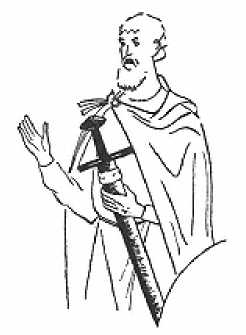
Fig. 8.
Figure from "The Gospels of Otto III". Bamberg. Made at Reichenau between 983-991.
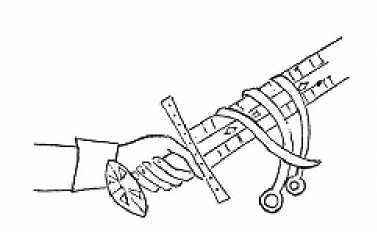
Fig. 9.
From a Sacramentary made in Regensburg between 1002-1024.
Have very wide Brazil-nut pommels (plate 2A); this is a clear distinction from Type VIII. Others (plate 2B) have a disc pommel. Here again there need be no confusion. It is only where a sword has a small Brazil-nut pommel and spike cross and an uninscribed blade that it may equally well be of either type.
There is a certain amount of variety in the shape of these blades, though most of them are identical. Some have very sharp points, some very blunt ones (though we may assume these to be corroded and broken off), though the majority have a subtly rounded point which looks as if it would be of little use in thrusting. Plate 2 gives examples of all three kinds of point, and the variations in the form of the fuller.
The type is adequately represented in art, though hardly at all in sculpture. This lack however is amply compensated by the frequency with which it appears in manuscript illustrations. The variety with the wide Brazil-nut pommel seems to have been very popular with German illuminators of the Ottonian period (c. 950-1050)13 (figs. 8 and 9) and appears again on decorated metalwork about 1100 (figs. 10 and 11).14
13E. G. Munich, Staatsbibliothek Cod. Lat. 4453, "Gospels of Otto III" between 983 and 991; many swords of Type VIIIA are also shown here, and one of Petersen's Type N (not included specifically in Wheeler's typology, but actually a version of Type VII); also Cod. Lat. 4456, a Sacramentary from the Cathedral Treasury at Bamberg, made for the Emperor Henry II between 1002 and 1024. A sword of Petersen's Type K—Wheeler's Type IV—appears in this MS; for many facsimiles from these and other MSS of the Ottonian period see Adolf Goldschmidt, Die Deutsche Buchmalerei, vol II, 1928.
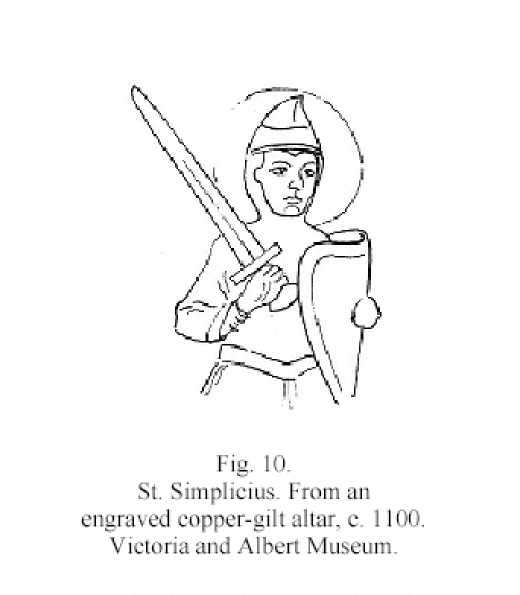
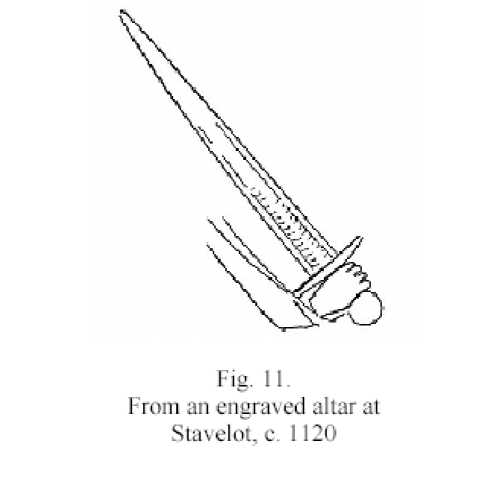




 World History
World History









